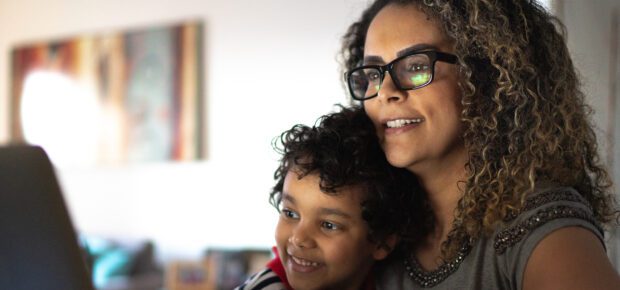September 27, 2021
Are the apps that children are using built with their well-being in mind? Here’s how to tell.
At their peak, school closures in response to the global pandemic affected more than 1.6 billion students worldwide, according to UNESCO data. The pandemic introduced a new, younger cohort to online learning. Schools around the world are exploring ways to continue online course offerings even after the pandemic ends.
Alongside the rise of online learning, a host of new educational applications have been launched to meet demand (and help parents balance remote learning and work-from-home). The design of these applications and the data they collect can have a significant impact on the well-being of children, who constitute one of the most vulnerable online demographics, for improved digital and real-world safety.
IEEE’s Ethically Aligned Design principles provide a vital framework for digital well-being. But it’s not always easy to tell how software developers and web designers have translated that framework to actual practice.
The IEEE Standards Association’s Case Study Report on Children’s Experiences looks at eleven applications made for children and students, and it highlights the nuts and bolts of companies that are getting it right.
The report tackles the big issues on the minds of parents and application designers alike.
- Data collection and privacy. Data collection is a sensitive topic for parents, who are acutely aware that even small amounts of information from disparate sources are used to identify children. Apps geared toward children tend to have data minimization procedures meaning they store only a minimum amount of data about users and their devices, while additional data may be stored on the device itself.
- Transparency and consent. When applications do store user data, it is a best practice to inform parents about exactly what is being collected and who has access to it. Some applications also detail who accessed a user’s data and when they did so.
- Building apps and systems that take human rights into account. Human rights make up a core pillar of ethically-aligned design. Translating that into practice means designing apps for a diverse population of young people that may have cognitive impairments, disabilities, different levels of income or any number of differences. Parents of these users may only have limited schooling themselves, presenting new challenges related to transparency and even the ability to help their children.
- Striking a balance between parental control and child empowerment. Lots of social media applications can feel like parent-free zones, and that might be part of the appeal for young people developing their own individuality. The report details how developers navigate parental consent and involvement in an age-appropriate way. Some apps, for example, rather than rely on content filters and parental controls, encourage parents to respect young users’ privacy, while providing guidelines for safe behavior.
- Mitigating the risk of harm. Privacy risks for children abound. Apps are using artificial intelligence to determine if a child is using their full name as a username, or if they are posting images of their face or body in apps.
Navigating the issues of privacy in the digital world can be cumbersome for adults but children require special consideration. For parents, the case studies found in the Case Study Report on Children’s Experiences project in 2020 show the many ways that companies are getting it right. For developers and digital marketers, these case studies can also serve as a springboard for important discussions.
Parents, of course, are stuck in a difficult spot. They’re commuting longer and working longer, while devices are keeping children occupied.
“Really, we should put the effort into monitoring what they’re doing,” IEEE Senior Member Kevin Curran told Ulster University’s ‘We Are UU podcast.’ “We should put the effort into understanding what’s a safe app to use.”
If you are interested in learning about how to create ethical and responsible digital ecosystems, consider this coursework from the IEEE Learning Network: AI Standards: Roadmap for Ethical and Responsible Digital Environments.
For more information on how parents are balancing remote work and childcare, check out this illuminating discussion.






 Meaningful Momentum or Running in Place?
Meaningful Momentum or Running in Place? AI Through Our Ages
AI Through Our Ages Liquid Infrastructure: Our Planet's Most Precious Resource
Liquid Infrastructure: Our Planet's Most Precious Resource The Impact of Technology in 2025
The Impact of Technology in 2025 Quantum and AI: Safeguards or Threats to Cybersecurity?
Quantum and AI: Safeguards or Threats to Cybersecurity? Why AI Can't Live Without Us
Why AI Can't Live Without Us Bits, Bytes, Buildings and Bridges: Digital-Driven Infrastructure
Bits, Bytes, Buildings and Bridges: Digital-Driven Infrastructure Impact of Technology in 2024
Impact of Technology in 2024 Emerging AI Cybersecurity Challenges and Solutions
Emerging AI Cybersecurity Challenges and Solutions The Skies are Unlimited
The Skies are Unlimited Smart Cities 2030: How Tech is Reshaping Urbanscapes
Smart Cities 2030: How Tech is Reshaping Urbanscapes Impact of Technology 2023
Impact of Technology 2023 Cybersecurity for Life-Changing Innovations
Cybersecurity for Life-Changing Innovations Smarter Wearables Healthier Life
Smarter Wearables Healthier Life Infrastructure In Motion
Infrastructure In Motion The Impact of Tech in 2022 and Beyond
The Impact of Tech in 2022 and Beyond Cybersecurity, Technology and Protecting Our World
Cybersecurity, Technology and Protecting Our World How Technology Helps us Understand Our Health and Wellness
How Technology Helps us Understand Our Health and Wellness The Resilience of Humanity
The Resilience of Humanity Harnessing and Sustaining our Natural Resources
Harnessing and Sustaining our Natural Resources Creating Healthy Spaces Through Technology
Creating Healthy Spaces Through Technology Exceptional Infrastructure Challenges, Technology and Humanity
Exceptional Infrastructure Challenges, Technology and Humanity The Global Impact of IEEE's 802 Standards
The Global Impact of IEEE's 802 Standards Scenes of our Cyber Lives: The Security Threats and Technology Solutions Protecting Us
Scenes of our Cyber Lives: The Security Threats and Technology Solutions Protecting Us How Millennial Parents are Embracing Health and Wellness Technologies for Their Generation Alpha Kids
How Millennial Parents are Embracing Health and Wellness Technologies for Their Generation Alpha Kids Space Exploration, Technology and Our Lives
Space Exploration, Technology and Our Lives Global Innovation and the Environment
Global Innovation and the Environment How Technology, Privacy and Security are Changing Each Other (And Us)
How Technology, Privacy and Security are Changing Each Other (And Us) Find us in booth 31506, LVCC South Hall 3 and experience the Technology Moon Walk
Find us in booth 31506, LVCC South Hall 3 and experience the Technology Moon Walk Virtual and Mixed Reality
Virtual and Mixed Reality How Robots are Improving our Health
How Robots are Improving our Health IEEE Experts and the Robots They are Teaching
IEEE Experts and the Robots They are Teaching See how millennial parents around the world see AI impacting the lives of their tech-infused offspring
See how millennial parents around the world see AI impacting the lives of their tech-infused offspring Take the journey from farm to table and learn how IoT will help us reach the rising demand for food production
Take the journey from farm to table and learn how IoT will help us reach the rising demand for food production Watch technical experts discuss the latest cyber threats
Watch technical experts discuss the latest cyber threats Explore how researchers, teachers, explorers, healthcare and medical professionals use immersive technologies
Explore how researchers, teachers, explorers, healthcare and medical professionals use immersive technologies Follow the timeline to see how Generation AI will be impacted by technology
Follow the timeline to see how Generation AI will be impacted by technology Learn how your IoT data can be used by experiencing a day in a connected life
Learn how your IoT data can be used by experiencing a day in a connected life Listen to technical experts discuss the biggest security threats today
Listen to technical experts discuss the biggest security threats today See how tech has influenced and evolved with the Games
See how tech has influenced and evolved with the Games Enter our virtual home to explore the IoT (Internet of Things) technologies
Enter our virtual home to explore the IoT (Internet of Things) technologies Explore an interactive map showcasing exciting innovations in robotics
Explore an interactive map showcasing exciting innovations in robotics Interactively explore A.I. in recent Hollywood movies
Interactively explore A.I. in recent Hollywood movies Get immersed in technologies that will improve patients' lives
Get immersed in technologies that will improve patients' lives